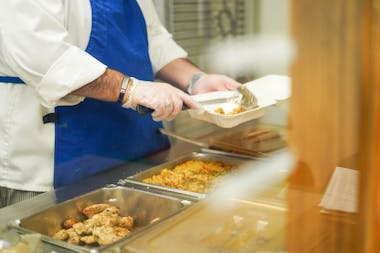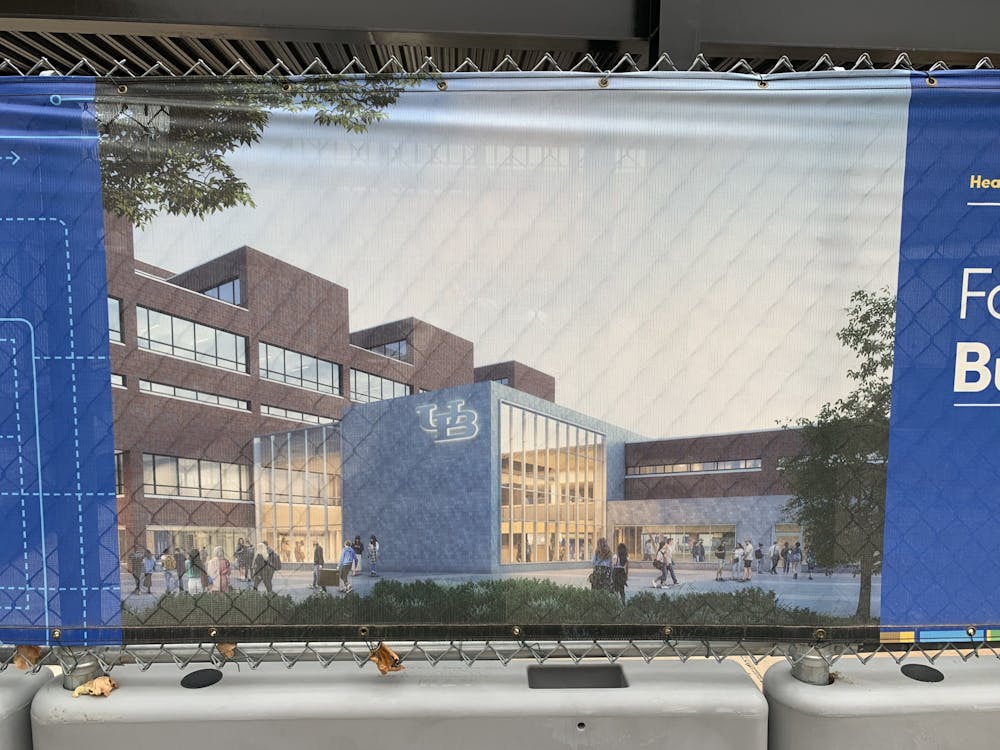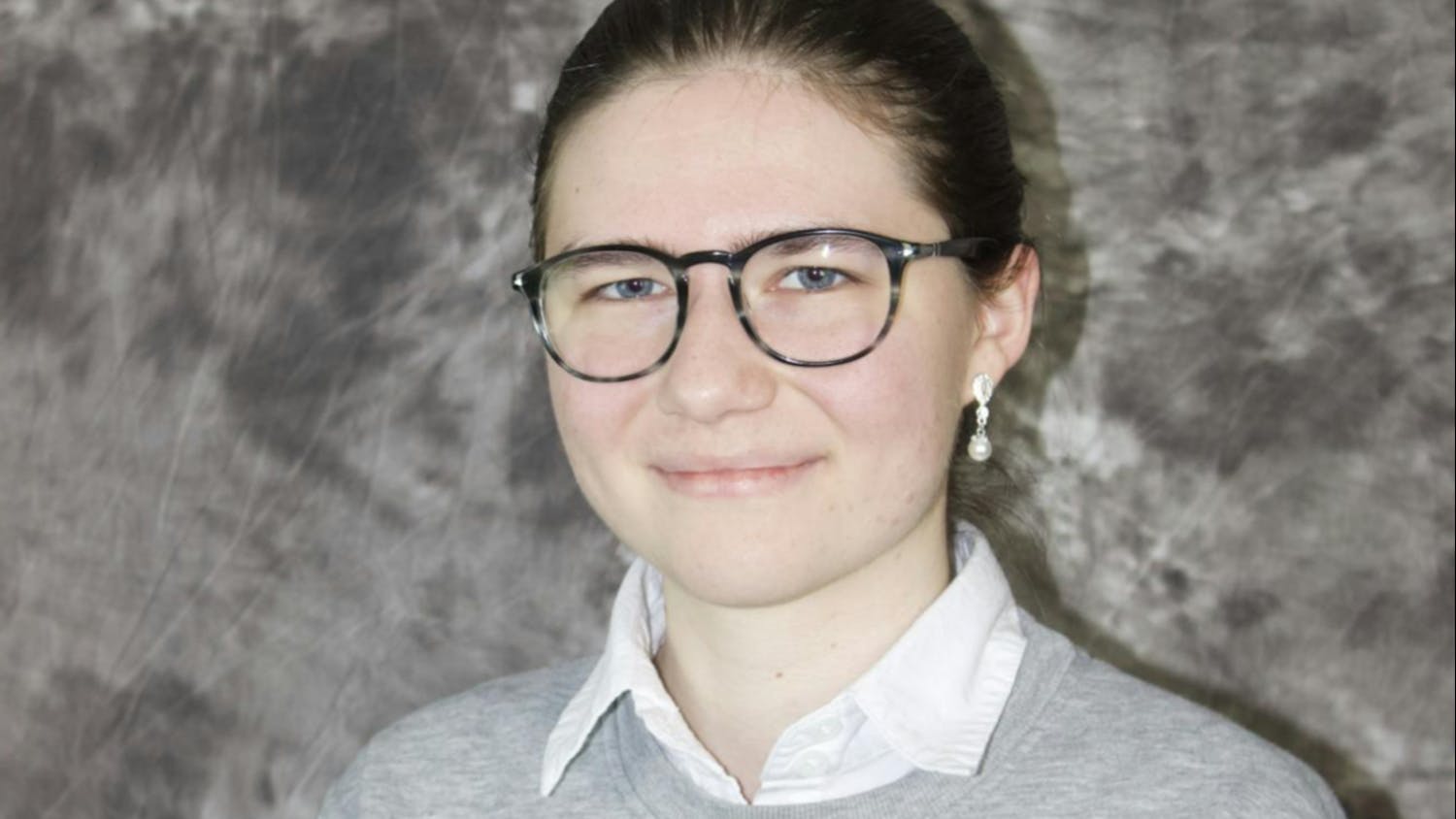Ten years ago, UB officials envisioned a colossal, international-themed eatery located at the beating heart of North Campus’ academic spine.
In Spring 2022, their vision will become reality.
Enter the One World Café — a three-story, 53,500-square-foot dining hall boasting international fare and community dining spaces designed for upwards of 800 visitors. The eatery will be situated under Capen Hall and adjacent to the Founders Plaza courtyard, and will create a “front door” to the university, officials hope.
But improving students’ dining experiences comes at a cost — $37.8 million to be exact, according to Carrie Woodrow, director of business compliance and internal controls at UB. That’s nearly triple the project’s original projected $14 million development cost. It comes out to $48,375 per seat.
Many students feel the cost is too high for what the eatery will offer and expressed surprise that the café project still moved forward, even amid pandemic-induced cuts which included a 10% reduction to all decanal and divisional units at UB.
Dining, many students said, is not as important to them as other, pressing needs, including mental health services, transportation, housing, graduate stipends and student life services, all of which students say have been exacerbated by the pandemic. Others question how much input students had in the process of creating the café, which UB insists was transparent and involved student representatives.
“The [millions] could have gone toward improving what was already here instead of basically starting from scratch,” Sarah Wack, a third-year combined History, BA and Masters in Education, EdM, said. The funding for the café, she said, lacked transparency and costs too much for what students are getting.
UB, for its part, says the majority of One World Café funds were reserved for dining projects, meaning the money didn’t come out of other university initiatives. Instead, the money came from three sources: the university ($14 million), SUNY construction funds ($3.3 million) and Campus Dining and Shops, UB’s for-profit dining vendor ($20.5 million).
Many students are also lamenting the loss of the popular campus eatery, Bert’s, and UB’s only kosher option, NY Deli & Diner. Bert’s closed to make way for One World Café and will be used as a COVID-19 surveillance testing site this semester.
The Bert’s dining hall, located across from the homonymous restaurant, used to sit 400 people, 400 fewer than One World Café. NY Deli & Diner offered unique items like knishes, matzo ball soup, falafel, Moroccan rice and corned beef and pastrami sandwiches — items that can’t be found anywhere else on campus and won’t be served at One World Café, according to CDS Marketing and Communications Director Ray Kohl.
Kohl added that menu development for One World Café is ongoing.
The committee overseeing the dining hall’s development, however, disbanded in 2020.
One World Café will not serve kosher food, Kohl said. But, UB’s Bulls on the Run Grab ‘n Go Kosher cold food offerings, which are currently offered at Harriman Hall and Capen Café, may also be available at One World Café as “options are being explored to accommodate various nutritional needs,” Kohl said.
“We foresee our current Grab ‘n Go line of kosher offerings being available at the One World Café until a new location can be secured through the university,” Kohl said.
Chinese food, sushi, a noodle bar and dishes inspired by 11 Indian regional cuisines are all on the menu at One World Café, Woodrow said.
Existing campus eateries already serve similar internationally-inspired foods: Chinese and Indian dishes are available at C3, while sushi is served in the Student Union. Japanese, Indian, Mediterranean and Chinese restaurants are all located in the Commons, as well.
Galia Wechsler, a junior history major who keeps kosher, says the One World Café’s planned offerings aren’t diverse or inclusive enough to warrant UB’s $38 million investment. Instead of making her feel welcome, the new café alienates her from her peers, she says.

The NY Deli & Diner, located in the basement of Talbert Hall, was UB’s only kosher option.
“I think UB is responsible for making sure all the dietary needs and restrictions of students can be met one way or another and therefore needs to find some way to fit kosher dining into their grand plans of One World Café,” Wechsler said. “There are students at UB who came here knowing there would be kosher food for them to eat and that was taken away from them. Especially as a flagship campus of the SUNY system, New York is a state with a large Jewish population and a big factor for Jewish students picking a college is accessibility and Jewish life, which, for many, includes kosher dining. Not attempting to accommodate these students is unwelcoming and inconsiderate.”
UB does not keep track of the number of students who keep kosher.
Sam Leifer, a junior business administration major, says UB’s current Grab ‘n Go Kosher meals are “just not the same” as “getting shawarma at the deli on Thursdays.” He says that he isn’t aware of any UB efforts to involve Jewish students in the future of kosher dining at UB, but believes UB should have “absolutely made more of an effort to expand kosher options” after closing Bert’s.
OWC’s menu also doesn’t include halal offerings.
Kohl says the culinary team behind UB’s dining options is still “looking at other Halal proteins and expanding locations where they can be purchased.”
Halal chicken is currently offered at Guac & Roll and The Bowl in the Ellicott Food Court, Harriman Café, Bravo Pasta at Pistachios in the Student Union and in select entrées Grab ‘n Go microwavable entrées sold around campus, he says.
But Leifer says UB’s culinary team must plan to expand existing menu options for students of all religious backgrounds as the university’s student body becomes increasingly diverse.
“UB’s website boasts that UB ‘has one of the most diverse communities in the United States,’ so they should be more accommodating to religious dietary options,” Leifer said.
“As far as engaging more students with different backgrounds [is concerned], I would say the best way [for UB] to find out what’s best would be by reaching out to the different religious groups on campus and asking how they feel about [the current food offerings]. Personally, I had not been reached out to about Jewish students’ dining hall options, but I don't know if other Jewish students have been.”
Students think more funds should be used for mental health services
Above all else, students are wondering why UB has increased funding for One World Café, but will not use university funds to hire more on-campus counselors.
Currently, counseling sessions at UB’s counseling centers are in high demand, and students are limited to 10 counseling sessions per academic year.
“I think students here have been asking for a long time for more counseling sessions [per year], and they keep dismissing it or telling us to go to meditation or anti-anxiety sessions instead, which they don’t realize are very different from [being able to access professional help],” Jenna Quinn, a sophomore psychology and criminology major and Spectrum social media editor, said.
“Spending the money on things that make the school look better or fancier on paper and ignoring what students are asking for shows how little they care,” Quinn continued. “[It’s either] that, or they’re just being irresponsible.”
From 2011 to 2020, construction costs for the One World Café nearly doubled from $14 million to $27 million. In 2021, total budget figures, including design fees, construction manager and contractor costs, and furniture, fixtures and equipment costs were solidified, tacking on another $10 million to the project’s projected costs.
In November, UB President Satish Tripathi warned the campus of UB’s dire financial health and warned the university would feel a “financial strain for the foreseeable future.” UB’s projected state revenue shortfalls were assessed at $13.3 billion for 2021 and $61 billion for 2024 due to the pandemic. Tripathi hoped to mitigate the shortfall by imposing a 10% budget cut on each of UB’s 12 decanal units.
One World Café construction continued amid the announced cuts. It stopped from April to May of last year, because of a state-ordered pause due to the pandemic.
Woodrow defended the café’s budget plan, insisting the project’s costs had not ballooned or been unexpectedly high. Budget adjustments, such as the 200% increase in the One World Cafe’s projected cost and funding, are “typical for projects of [the One World Café’s] scope and complexity,” she said.
“The 2011 number was projected prior to the design and planning process but as part of planning for the Heart of the Campus,” Woodrow said. “Once these phases were complete for OWC, the budget was adjusted to ensure that the project would meet the project team’s goal.”
The Heart of the Campus is a UB 2020 initiative that seeks to enhance the “learning landscape” in the academic spine. One World Café is the third phase of this initiative, after 2016 renovations to the Oscar A. Silverman Library and the 2017 completion of 1Capen.
Café costs
When the project is completed, the One World Café will have required around $14 million in university funds, and over $3.3 million in SUNY construction funds.
The Faculty Student Association (FSA), a non-profit organization which encompasses UB’s for-profit dining vendor, CDS, will foot the remainder of the bill — $20.5 million — with funds designated for the project and raised through student dining, concessions and vending machine sales. In 2019, FSA made $47,338,511 in total revenue and netted $6,449,476 in profits, according to the organization's IRS 990 form for that year. Woodrow says “a majority” of the café’s sticker price will come from funds reserved specifically for the project.
“A majority of the funding for One World Café is designated for this project only,” Woodrow said. “That means these designated funds can only be used for the purpose of upgrading or building new dining facilities, including design work, the bidding process and construction management for this project.”
The Spectrum asked for a breakdown of UB’s funding sources and an explanation of how the university stored and allocated those funds for different projects across campus.
“The university receives income from all the sources you’ve listed below (tuition, grants, donations, etc.),” Woodrow wrote. “However, once received, money isn’t necessarily spent out of those same buckets, unless specified from the source (like grants or donations). Therefore, when I say ‘university funds’ it would be any funds held by the university that are not earmarked for another use.”

During the One World Café’s development period, FSA’s net assets increased 470.706% — from $7,510,019 in 2011 to $42,860,148 in 2019.
One World Café is slated to open in spring 2022, officials say. The project includes a nearly $1.2 million “University Club,” which is designed in large part as a hang-out space for administrators.
The University Club will feature a bar, a kitchen, big-screen viewing facilities and two conference rooms, according to design sketches from Cannon Design. The space will cost $1.84 million in university funds, including $784,000 for the club’s fit-out and $400,000 for furniture and equipment.
Woodrow says the University Club will provide “much-needed space” for UB faculty and staff.
“The University Club at UB will be designed to provide much-needed space for faculty and staff to host meetings, conferences and cater special events in addition to providing food service during the week,” she said.
The club “may” also provide event space for SA clubs on a reservation basis, she said.
Woodrow says the concept is “common among colleges and universities.” Schools like Arizona State University boast university clubs that are open to “current and retired faculty, staff, alumni, community and corporate sponsors.”
Andrea Lim, a 2021 graduate who studied communication, doesn’t see why UB and FSA would be compelled to invest “so much money” into a dining hall that’s “so fancy,” except to improve the school’s image and attract new students.
One World Café’s total cost roughly equals the combined projected costs of replacing the fire alarm systems around North Campus ($24.625 million), renewing UB’s electrical infrastructure ($5.772 million) and rehabilitating roadways and sidewalks across North and South Campus ($10.222 million), according to the 2020 State University of New York Summary of Budgetary Changes Capital Program Plan.
“I don’t see why a campus dining hall has to be so fancy,” Lim said. “I would say the café really is to build a better image for the school but is not at all beneficial to students.”
But administrators argue that One World Café will meet rising dining demands fueled by UB’s steadily increasing enrollment numbers by offering 160 more seats for students to study, socialize and dine.
UB recorded record-high enrollment numbers in the fall, with 32,347 students, according to the university’s factbook.
“It will meet the need for expanded dining facilities among UB’s campus population, while also serving as a center for students, faculty and staff to meet and socialize in a multicultural environment,” Woodrow said.
Lim disagrees with the assumption that more students would result in increased demand for on-campus dining. Many students, like herself and her neighbors at UB’s on-campus apartments for upperclassmen, prefer to eat food from off-campus eateries or prepare their own food at home once they’ve exhausted their freshman-year meal plans and graduated to the fully-equipped kitchens of UB’s apartments, she says.
“I am currently living at Flint [Village] and I see my neighbors ordering DoorDash and Uber Eats almost everyday instead of eating on campus,” Lim said last semester. “I also eat out with my friends on most days because we almost never want to eat on campus.”
Student Involvement in One World Café Development
Quinn, who expressed concern about the university’s counseling services, says she believes administrators’ decision to green-light the café was not informed by student opinions.
She says she feels UB officials may have intentionally under-surveyed students about the café for fear that collecting a wider range of student opinions about the new project would uncover, or awaken, student opposition to the café’s construction.
“I think UB wants to get student opinions but for some reason, whether they think it will cast a negative light on the school or lower its reputation, they aren’t actively searching for them,” Quinn said. “UB communicates daily to its students through email, social media and even texting with daily health checks/emergency alerts. They’re in constant contact with the student body and could have used any one of those platforms to gather opinions on [One World Café] and which other services should get more money instead.”
FSA’s 18 members, six of whom are students, were heavily involved in One World Café decision making, according to Woodrow.
UB also engaged with students outside of that realm — particularly with student government leaders — at several stages of the café’s planning and design processes, Woodrow said.
“Many UB students have helped shape this project, each contributing in different and important ways. To help guide its formal design process, UB and CannonDesign engaged the UB community, soliciting input on various aspects of the design and food service dimensions of the project,” Woodrow said. “We wanted to be sure that we had the benefit of a broad sampling of ideas and suggestions to help fashion the best possible design that meets the needs, and best serves, the diverse university community.”
In October 2017, students were invited to attend a series of focus groups, during which they viewed renderings of OWC, and talked to CannonDesign project members.
Students also sampled some potential dining options: chopped Thai salad with sesame garlic dressing, chicken Biryani with naan and open-faced carnitas with Arbol sauce.
The single-day event was advertised through the “Student Association as well as flyers on campus.”
The event attracted 1,286 participants, which represented 4.2% of UB’s student body in 2017.
Over 600 participants, or 2% of UB students, completed a food preference survey.
The university strived to obtain a “broad sampling of ideas and suggestions” to develop plans that will best serve the campus community, Woodrow said.
UB also formed a committee to helm the project and guide design developments from 2017 to 2020. The committee, which only existed during those three years and is now inactive, counted UB’s then-SA and Graduate SA presidents among its members.
“[2017-2020] was the most critical time for student input,” Woodrow said. “The SA president and the GSA president, at that time, were members of the steering committee, as well as the communications sub-committee. SA’s International Council Coordinator was also a member of the steering committee. It was critical that they were involved, asking questions and providing input on behalf of the undergraduate and graduate student body.”
Quinn says One World Café’s final design could have better reflected “diverse student interests” had the university solicited opinions from students who are not involved with the Student Association.
SA leaders, she says, already have a platform by which they can elevate their voices and effect change on campus. Most UB students, however, do not.
“I think UB wants to get student opinions but for some reason, either if they think it will cast a negative light on the school or lower its reputation, they aren’t actively searching for them,” Quinn said. “I think UB students have had strong opinions to better the school for a while, but unless you’re deeply involved with RHA, Student Government, or are a part of paraprofessional employment, which are insanely selective/limited given the size of the student body, your voice won’t be heard as much. They don’t try as hard to get the opinions of regular students.”
CORRECTION: A previous version of this article claimed the cost of the One World Café was $38.7 million. The correct cost is $37.8 million.
Elizabeth Napolitano is the former senior news editor and can be reached at elizabeth.napolitano@ubspectrum.com
Jack Porcari is the co-senior news editor and can be reached at jack.porcari@ubspectrum.com
Elizabeth "Liz" Napolitano is the senior news editor for The Spectrum. She's an optimistic pessimist who found her love for journalism in Ecuador. She likes late night walks and reading Twitter threads in their entirety.

Jack Porcari is a senior news/features editor at The Spectrum. He is a political science major with a minor in journalism. Aside from writing and editing, he enjoys playing piano, flow arts, reptiles and activism.





